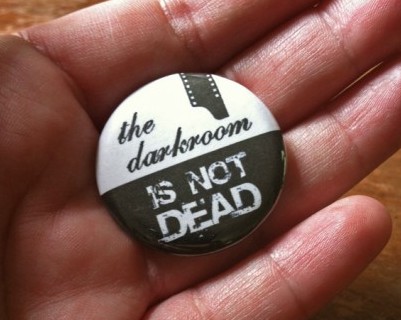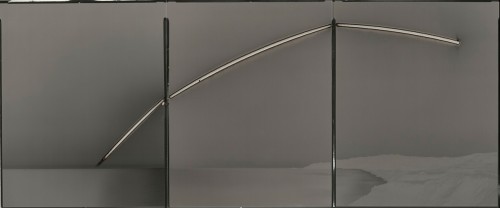Chris McCaw, “Sunburned GSP #733 (Pacific Ocean),” 2013
Three Unique Gelatin Silver Paper Negatives
10″ × 8″ (25.4 × 20.3 cm) each element
I am teaching Alt Process at Warren Wilson College this semester, and I made it a point to have our first class discussion be defining what Alt Process means. I was pleased that their findings led them to a cross between silver-based and non-silver processes: solarization, bromoil, anthotypes, pinhole images. Their perspective confirmed my feelings that the “traditional” definition of Alt Process, tightly linked to non-silver processes such as cyanotype, or historical processes like salt printing, is outdated and has grown to embrace the traditional darkroom.
Not that this discussion is particularly new. In April 2015, Dan Estabrook organized a panel discussion at Penland School of Crafts with Christina Z Anderson, Jerry Spagnoli, France Scully Osterman, and other participants to discuss the current state of, shall we say, chemical photography. We recognized the fad of Alt Process work and how it is frequently used as a crutch to skirt around concept or even technical mastery. We also debated just what is the proper term to encompass these processes, since”Alt Process” at one point meant an alternative to the gelatin silver prints of the traditional darkroom. The darkroom is itself an Alt Process to the mainstream of digital now.
There is simply so much to explore with developer, stop, fix, and silver. No one would consider Chris McCaw’s “Sunburn” series traditional in any way, yet it is achieved with basic silver paper negatives. Alison Rossiter explores non-objective form with decades-old expired and rare papers to which she simply applies chemicals, bypassing negative-based imagery altogether. Even the once most widespread commercial-based form of photographic imagery, the c-print, is harnessed by Marco Breuer to merge photographic materials in with concerns about drawing and physical manipulation. In short, I don’t think we need a brush and a UV lightbox to create imagery with any sort of label of “alternative”.
I am pleased that I have been given an opportunity to explore these ideas further with students in an upcoming class at Penland: Gelatin Silver as Alt Process. Running from July 10-22, we will explore ways to make photographic art with traditional darkroom chemistry. The methods are geared towards darkroom beginners: composite printing, solarization, selective development, paper negative manipulation, chromoskedasic sabattier. I am also looking forward to introducing chemigrams into the mix, introducing the techniques from my Language Acquisition series. Registration for the workshop is open, and the deadline for the Scholarship Application is February 17th.
I feel lucky to be a photographic artist at this time in history. There is so much to be redefined and rediscovered.

